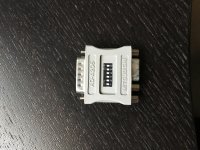Well, this is surely somewhat of an oddity, as far as topics in this Conquests forum goes, but, I thought it would be appropriate to put it here.
So, I bought a projector recently. It is a Proxima Ultralight LS2. Now, you might be thinking, "Cool! It's a projector. But, how exactly does this relate to Macintosh?", well, for one it came with a Mac DA-15 to VGA adaptor, the one with six dip switches. But, the second reason(s) are why it is so appealing.
This projector does MultiSync like I have never seen before. It supports every obscure Mac resolution I've thrown at it so far, even identifying it as "Mac 13", or "Mac 16", etc. in the OSD. It syncs perfectly to those. But, it also does something else which I found very awesome- It supports IIgs video output.
Now, this is where we go into the "What were you thinking MK, were you trying to let the magic smoke out??" part. I already have the Mac video pinout pretty much memorized from working on my ADB KVM, and I checked out the pinout of the IIgs video port. Both are DA-15 connectors, and both have their R,G and B signal lines on the same pins. But this is where the stupid part beings, I decide to hook up my Mac VGA adaptor which I have used for quite a few things, and also hook up a VGA cable using that between my IIgs and this projector. And, it worked. Additionally, the OSD of the projector identifies the HSYNC and VSYNC rates correctly, as well as calling it "Analog RGB". Very cool, I honestly didn't expect this to work.
As always, pictures!: (Oh, and be sure to read the titles/descriptions I have given to each of the pictures)
Another interesting things is Gorgonops was talking about syncing and projectors, as well as a specific monitor in this thread: https://68kmla.org/forums/index.php?/topic/30554-mac-plus-external-video-mod-ttl-to-vga/?p=331885
So, I bought a projector recently. It is a Proxima Ultralight LS2. Now, you might be thinking, "Cool! It's a projector. But, how exactly does this relate to Macintosh?", well, for one it came with a Mac DA-15 to VGA adaptor, the one with six dip switches. But, the second reason(s) are why it is so appealing.
This projector does MultiSync like I have never seen before. It supports every obscure Mac resolution I've thrown at it so far, even identifying it as "Mac 13", or "Mac 16", etc. in the OSD. It syncs perfectly to those. But, it also does something else which I found very awesome- It supports IIgs video output.
Now, this is where we go into the "What were you thinking MK, were you trying to let the magic smoke out??" part. I already have the Mac video pinout pretty much memorized from working on my ADB KVM, and I checked out the pinout of the IIgs video port. Both are DA-15 connectors, and both have their R,G and B signal lines on the same pins. But this is where the stupid part beings, I decide to hook up my Mac VGA adaptor which I have used for quite a few things, and also hook up a VGA cable using that between my IIgs and this projector. And, it worked. Additionally, the OSD of the projector identifies the HSYNC and VSYNC rates correctly, as well as calling it "Analog RGB". Very cool, I honestly didn't expect this to work.
As always, pictures!: (Oh, and be sure to read the titles/descriptions I have given to each of the pictures)
Another interesting things is Gorgonops was talking about syncing and projectors, as well as a specific monitor in this thread: https://68kmla.org/forums/index.php?/topic/30554-mac-plus-external-video-mod-ttl-to-vga/?p=331885
Last edited by a moderator:


